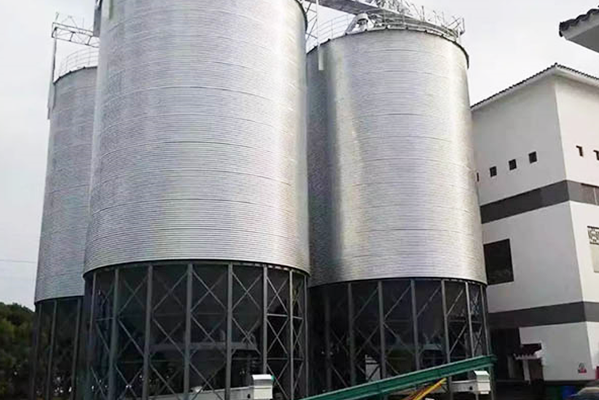Navigation Menu
Contact Us
- Email:
- info@wxavatar.com
- Address:
- Yurong Village, Yuqi Street, Huishan District, Wuxi, China.
Release Date:Mar 15, 2025 Visit:57 Source:Roll Forming Machine Factory
Storing grain in a warehouse is a common and effective method for preserving large quantities of grains while maintaining their quality and safety. Warehouses provide a controlled environment that can be adapted to meet the specific needs of grain storage, making them a popular choice for farmers, distributors, and agricultural businesses. However, successful grain storage in a warehouse requires careful planning, proper infrastructure, and adherence to best practices. This article explores the key techniques and considerations for storing grain in a warehouse to ensure optimal preservation and minimize losses.
Key Considerations for Storing Grain in a Warehouse
1.Warehouse Preparation
Before storing grain, it is essential to prepare the warehouse to create a suitable environment. This includes cleaning the facility to remove any residual grains, dust, or pests from previous storage cycles. Inspecting the warehouse for structural integrity, such as checking for leaks, cracks, or weak spots, is also crucial to prevent moisture ingress or pest infestations.
2.Moisture Control
Moisture is one of the biggest threats to grain quality during storage. Grains should be dried to the recommended moisture level before being placed in the warehouse. Additionally, the warehouse should be equipped with proper ventilation systems to regulate humidity and prevent condensation. Dehumidifiers or desiccants can also be used to maintain a dry environment.

3.Temperature Management
Temperature fluctuations can lead to spoilage, mold growth, or insect activity. Warehouses should be designed to maintain a consistent temperature, ideally between 10°C and 20°C (50°F and 68°F), depending on the type of grain. Insulated walls, climate control systems, and regular temperature monitoring can help achieve this.
4.Pest Prevention
Pests such as insects and rodents can cause significant damage to stored grains. To prevent infestations, warehouses should be sealed tightly, with no gaps or openings. Regular inspections and the use of pest control measures, such as traps, fumigation, or natural repellents, are essential. Storing grains in pest-resistant containers or bags can also provide an additional layer of protection.
5.Proper Stacking and Aeration
Grains should be stacked in a way that allows for adequate airflow to prevent heat buildup and moisture accumulation. Using pallets or raised platforms can help keep grains off the floor, reducing the risk of moisture absorption. Aeration systems, such as fans or ducts, can be installed to circulate air and maintain uniform conditions throughout the warehouse.
Techniques for Storing Grain in a Warehouse
1.Bulk Storage
Bulk storage involves piling grains directly onto the warehouse floor or in large containers. This method is cost-effective and suitable for large quantities of grains. However, it requires careful monitoring of temperature, moisture, and pest activity to prevent spoilage.
2.Bagged Storage
Grains can also be stored in bags made from durable materials like woven polypropylene. Bagged storage allows for better organization and easier handling, especially for smaller quantities or different grain varieties. Bags should be stacked neatly and kept off the floor to ensure proper ventilation.
3.Silo Storage Within Warehouses
Some warehouses incorporate smaller silos or bins within the facility to store grains. This method combines the benefits of bulk storage with the added protection of silo structures, which are designed to control environmental factors more effectively.
4.Use of Hermetic Storage Solutions
Hermetic storage systems, such as airtight bags or containers, can be used within warehouses to create oxygen-deprived environments. This method is highly effective in preventing pest infestations and mold growth without the need for chemical treatments.

Monitoring and Maintenance
Regular monitoring is essential for successful grain storage in a warehouse. This includes checking temperature and humidity levels, inspecting for pests, and assessing grain quality. Automated monitoring systems equipped with sensors and IoT technology can provide real-time data and alerts, enabling timely interventions. Additionally, routine maintenance of the warehouse infrastructure, such as repairing leaks or updating ventilation systems, ensures long-term reliability.
Storing Grain in Warehouse: A Foundation for Food Security
In conclusion, storing grain in a warehouse is a practical and efficient solution for preserving large quantities of grains. By focusing on moisture control, temperature management, pest prevention, and proper stacking techniques, warehouses can provide a safe and controlled environment for grain storage. Incorporating modern technologies, such as automated monitoring and hermetic storage solutions, further enhances the effectiveness of warehouse storage. As global food demand continues to grow, storing grain in warehouses will remain a cornerstone of agricultural practices, ensuring food security and reducing post-harvest losses. Storing grain in a warehouse is not just a method—it is a commitment to safeguarding our food supply for future generations.